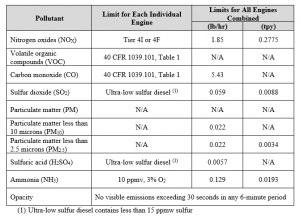Texas Releases New Readily Available Permit (RAP) for Power Generation Engines
Posted: June 16th, 2022
Authors: Christopher W.
The Air Permits Division (APD) at the Texas Commission on Environmental Quality (TCEQ) has released a new Readily Available Permit (RAP) for power generation engines. The RAP can be used to authorize up to 10 diesel-fired engines used for the purpose of generating power and 10 associated diesel fuel storage tanks. It cannot be used to amend an existing New Source Review (NSR) preconstruction permit and is only allowed for the issuance of an initial permit.
What is a RAP?
A RAP is a case-by-case minor NSR preconstruction permit that APD has developed to streamline the process for reviewing and issuing the final permit. RAPs exist for certain types of facilities where the character of emissions and associated emissions calculations are consistent, and a standard set of special conditions can be defined by the TCEQ. When a proposed project meets the specific criteria defined by a RAP, it qualifies for the more efficient review process associated with these types of permits. The applicant fills out the RAP workbook for the relevant facility type and submits the required application documents through the State of Texas Environmental Electronic Reporting System (STEERS). Note that RAPs do not require modeling as part of this streamlined permitting process. In most cases, RAPs will qualify for a consolidated public notice where the requirements for both 1st and 2nd public notice are met with a single action. The expected result is that the final permit is obtained in less time than if a traditional minor NSR permit application had been submitted.
What types of projects qualify for the power generation engine RAP?
The power generation engine RAP can be used to authorize projects involving the installation of up to 10 diesel-fired engines and 10 associated diesel storage tanks that meet the following criteria:
- The engines are used to generate power.
- The RAP is for an initial permit issuance only and not proposing to amend an existing NSR permit.
- Project emissions increases, without considering any decreases, do not exceed the Prevention of Significant Deterioration (PSD) or Nonattainment New Source Review (NNSR) major source thresholds at existing minor sites or the significant emissions rates at existing major sites.
- The project does not result in any upstream or downstream production increases.
- The customer has a compliance history classification of Satisfactory or High.
- The emissions do not exceed the limits prescribed by the RAP.
- The engine and tanks can comply with all representations and special conditions specified by the RAP.
What are the maximum emissions allowed for engines to qualify for the RAP?
The engines authorized by the RAP must comply with the following emissions limits:
What are the maximum emissions allowed for diesel tanks to qualify for the RAP?
The tanks authorized by the RAP must comply with the following emissions limits:
With what special conditions and RAP representations do my engine(s) and storage tank(s) need to comply?
The engines and tanks authorized by the RAP will be required to comply with the following conditions and permit representations:
- Engines authorized by the RAP are limited to a combined total of 300 hours of operation per rolling 12-month period.
- Engine stack parameters must meet the following minimum requirements: height ≥ 25 ft, diameter ≥ 0.66 ft, temperature ≥ 828 degree F, and velocity ≥ 168.7 ft/s.
- Selective Catalytic Reduction (SCR) must be in operation for any engine that is equipped.
- A non-resettable runtime meter must be installed on all engines.
- For engines in Houston-Galveston-Brazoria (HGB) or Dallas-Fort Worth (DFW) ozone nonattainment areas, the engine cannot operate for testing or maintenance between 6:00 AM and noon except if manufacturer’s testing requires a run of over 18 consecutive hours or if you are verifying the reliability of emergency equipment immediately after unforeseen repairs.
- All startups and shutdowns of an engine for which any control device is not in operation shall not exceed 30 minutes per event.
- No more than one diesel tank can be filled at one time.
- The total amount of time diesel tank filling operations occur in a year cannot exceed 24 hours per rolling 12-month period.
- Tanks must utilize submerged fill and all uninsulated exterior surfaces exposed to the sun must be white or aluminum.
- Records of the engine manufacturer’s design and operation specifications and all emissions-related maintenance requirements, hours of operation, fuel delivery date, quantities delivered, duration of tank filling, fuel sulfur content, engine maintenance, and visible emission observations must be maintained.
What’s the Bottom Line?
The power generation engine RAP is intended to provide a more efficient process for obtaining a minor NSR permit for power generating diesel-fired engines and their associated diesel storage tanks in the state of Texas. ALL4 is available to help you evaluate whether the RAP is the right choice for your project and can provide support preparing all application documents necessary to obtain a final permit. If you have questions, please reach out to Christopher Ward at cward@all4inc.com.



